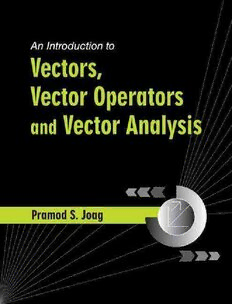
An Introduction to Vectors, Vector Operators and Vector Analysis PDF
Preview An Introduction to Vectors, Vector Operators and Vector Analysis
An Introduction to Vectors, Vector Operators and Vector Analysis Conceived as s a supplementary text and reference book for undergraduate and graduate students of science and engineering, this book intends communicating the fundamental conceptsofvectorsandtheirapplications.Itisdividedintothreeunits.Thefirstunitdeals with basic formulation: both conceptual and theoretical. It discusses applications of algebraic operations, Levi-Civita notation and curvilinear coordinate systems like spherical polar and parabolic systems. Structures and analytical geometry of curves and surfacesiscoveredindetail. Thesecondunitdiscussesalgebraofoperatorsandtheirtypes. Itexplainstheequivalence between the algebra of vector operators and the algebra of matrices. Formulation of eigenvectorsandeigenvaluesofalinearvectoroperatorarediscussedusingvectoralgebra. TopicsincludingMohr’salgorithm,Hamilton’stheoremandEuler’stheoremarediscussed indetail. Theunitendswithadiscussionontransformationgroups,rotationgroup,group ofisometriesandtheEuclideangroup,withapplicationstorigiddisplacements. The third unit deals with vector analysis. It discusses important topics including vector valuedfunctionsofascalarvariable,functionsofvectorargument(bothscalarvaluedand vectorvalued): thuscoveringboththescalarandvectorfieldsandvectorintegration PramodS.Joag is presently working as CSIR Emeritus Scientist at the Savitribai Phule University of Pune, India. For over 30 years he has been teaching classical mechanics, quantummechanics,electrodynamics,solidstatephysics,thermodynamicsandstatistical mechanics at undergraduate and graduate levels. His research interests include quantum information, and more specifically measures of quantum entanglement and quantum discord, production of multipartite entangled states, entangled Fermion systems, models ofquantumnonlocalityetc. An Introduction to Vectors, Vector Operators and Vector Analysis Pramod S. Joag 4843/24,2ndFloor,AnsariRoad,Daryaganj,Delhi-110002,India CambridgeUniversityPressispartoftheUniversityofCambridge. ItfurtherstheUniversity’smissionbydisseminatingknowledgeinthepursuitof education,learningandresearchatthehighestinternationallevelsofexcellence. www.cambridge.org Informationonthistitle:www.cambridge.org/9781107154438 ©PramodS.Joag2016 Thispublicationisincopyright.Subjecttostatutoryexception andtotheprovisionsofrelevantcollectivelicensingagreements, noreproductionofanypartmaytakeplacewithoutthewritten permissionofCambridgeUniversityPress. Firstpublished2016 PrintedinIndia AcataloguerecordforthispublicationisavailablefromtheBritishLibrary LibraryofCongressCataloging-in-PublicationData Names:Joag,PramodS.,1951-author. Title:Anintroductiontovectors,vectoroperatorsandvectoranalysis/ PramodS.Joag. Description:Daryaganj,Delhi,India:CambridgeUniversityPress,2016.| Includesbibliographicalreferencesandindex. Identifiers:LCCN2016019490|ISBN9781107154438(hardback)|ISBN110715443X (hardback) Subjects:LCSH:Vectoranalysis.|Mathematicalphysics. Classification:LCCQC20.7.V4J632016|DDC512/.5–dc23LCrecordavailableat https://lccn.loc.gov/2016019490 ISBN978-1-107-15443-8Hardback CambridgeUniversityPresshasnoresponsibilityforthepersistenceoraccuracy ofURLsforexternalorthird-partyinternetwebsitesreferredtointhispublication, anddoesnotguaranteethatanycontentonsuchwebsitesis,orwillremain, accurateorappropriate. ToElaandNinad whomademewritethisdocument Contents Figures xiii Tables xx Preface xxi Nomenclature xxv I Basic Formulation 1 GettingConceptsandGatheringTools 3 1.1 VectorsandScalars 3 1.2 SpaceandDirection 4 1.3 RepresentingVectorsinSpace 6 1.4 AdditionanditsProperties 8 1.4.1 Decompositionandresolutionofvectors 13 1.4.2 Examplesofvectoraddition 16 1.5 CoordinateSystems 18 1.5.1 Right-handed(dextral)andleft-handedcoordinatesystems 18 1.6 LinearIndependence,Basis 19 1.7 ScalarandVectorProducts 22 1.7.1 Scalarproduct 22 1.7.2 Physicalapplicationsofthescalarproduct 30 1.7.3 Vectorproduct 32 1.7.4 Generalizingthegeometricinterpretationofthevectorproduct 36 1.7.5 Physicalapplicationsofthevectorproduct 38 1.8 ProductsofThreeorMoreVectors 39 1.8.1 Thescalartripleproduct 39 1.8.2 Physicalapplicationsofthescalartripleproduct 43 1.8.3 Thevectortripleproduct 45 1.9 HomomorphismandIsomorphism 45 viii Contents 1.10 IsomorphismwithR3 45 1.11 ANewNotation: Levi-CivitaSymbols 48 1.12 VectorIdentities 52 1.13 VectorEquations 54 1.14 CoordinateSystemsRevisited: CurvilinearCoordinates 57 1.14.1 Sphericalpolarcoordinates 57 1.14.2 Paraboliccoordinates 60 1.15 VectorFields 67 1.16 OrientationofaTripletofNon-coplanarVectors 68 1.16.1 Orientationofaplane 72 2 VectorsandAnalyticGeometry 74 2.1 StraightLines 74 2.2 Planes 83 2.3 Spheres 89 2.4 ConicSections 90 3 PlanarVectorsandComplexNumbers 94 3.1 PlanarCurvesontheComplexPlane 94 3.2 ComparisonofAnglesBetweenVectors 99 3.3 AnharmonicRatio: ParametricEquationtoaCircle 100 3.4 ConformalTransforms,Inversion 101 3.5 Circle: ConstantAngleandConstantPowerTheorems 103 3.6 GeneralCircleFormula 105 3.7 CircuitImpedanceandAdmittance 106 3.8 TheCircleTransformation 107 II Vector Operators 4 LinearOperators 115 4.1 LinearOperatorsonE 115 3 4.1.1 Adjointoperators 117 4.1.2 Inverseofanoperator 117 4.1.3 Determinantofaninvertiblelinearoperator 119 4.1.4 Non-singularoperators 121 4.1.5 Examples 121 4.2 FramesandReciprocalFrames 124 4.3 SymmetricandSkewsymmetricOperators 126 4.3.1 Vectorproductasaskewsymmetricoperator 128 Contents ix 4.4 LinearOperatorsandMatrices 129 4.5 AnEquivalenceBetweenAlgebras 130 4.6 ChangeofBasis 132 5 EigenvaluesandEigenvectors 134 5.1 EigenvaluesandEigenvectorsofaLinearOperator 134 5.1.1 Examples 138 5.2 SpectrumofaSymmetricOperator 141 5.3 Mohr’sAlgorithm 147 5.3.1 Examples 151 5.4 Spectrumofa2×2SymmetricMatrix 155 5.5 SpectrumofSn 156 6 RotationsandReflections 158 6.1 OrthogonalTransformations: RotationsandReflections 158 6.1.1 Thecanonicalformoftheorthogonaloperatorforreflection 161 6.1.2 Hamilton’stheorem 164 6.2 CanonicalFormforLinearOperators 165 6.2.1 Examples 168 6.3 Rotations 170 6.3.1 Matricesrepresentingrotations 176 6.4 ActiveandPassiveTransformations: Symmetries 180 6.5 EulerAngles 184 6.6 Euler’sTheorem 188 7 TransformationGroups 191 7.1 DefinitionandExamples 191 7.2 TheRotationGroupO+(3) 196 7.3 TheGroupofIsometriesandtheEuclideanGroup 199 7.3.1 Chaslestheorem 204 7.4 SimilaritiesandCollineations 205 III Vector Analysis 8 Preliminaries 215 8.1 FundamentalNotions 215 8.2 SetsandMappings 216 8.3 ConvergenceofaSequence 217 8.4 ContinuousFunctions 220 x Contents 9 VectorValuedFunctionsofaScalarVariable 221 9.1 ContinuityandDifferentiation 221 9.2 GeometryandKinematics: SpaceCurvesandFrenet–SeretFormulae 225 9.2.1 Normal,rectifyingandosculatingplanes 236 9.2.2 Orderofcontact 238 9.2.3 Theosculatingcircle 239 9.2.4 Naturalequationsofaspacecurve 240 9.2.5 Evolutesandinvolutes 243 9.3 PlaneCurves 248 9.3.1 Threedifferentparameterizationsofanellipse 248 9.3.2 Cycloids,epicycloidsandtrochoids 253 9.3.3 Orientationofcurves 258 9.4 ChainRule 263 9.5 ScalarIntegration 263 9.6 TaylorSeries 264 10 FunctionswithVectorArguments 266 10.1 NeedfortheDirectionalDerivative 266 10.2 PartialDerivatives 266 10.3 ChainRule 269 10.4 DirectionalDerivativeandtheGradOperator 271 10.5 Taylorseries 278 10.6 TheDifferential 279 10.7 VariationonaCurve 281 10.8 GradientofaPotential 282 10.9 InverseMapsandImplicitFunctions 283 10.9.1 Inversemappingtheorem 284 10.9.2 Implicitfunctiontheorem 285 10.9.3 Algorithmtoconstructtheinverseofamap 287 10.10 DifferentiatingInverseFunctions 291 10.11 JacobianfortheCompositionofMaps 294 10.12 Surfaces 297 10.13 TheDivergenceandtheCurlofaVectorField 304 10.14 DifferentialOperatorsinCurvilinearCoordinates 313 11 VectorIntegration 323 11.1 LineIntegralsandPotentialFunctions 323 11.1.1 Curlofavectorfieldandthelineintegral 341
